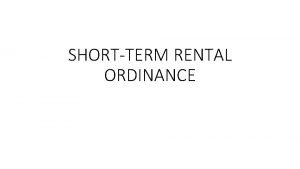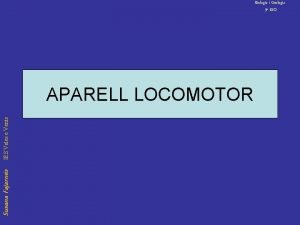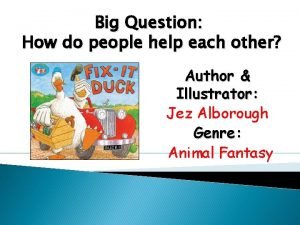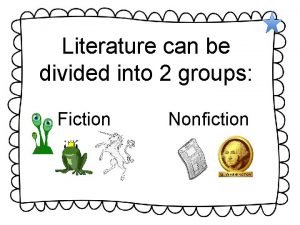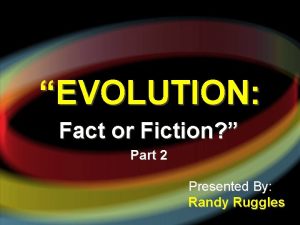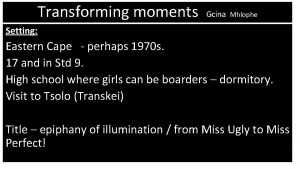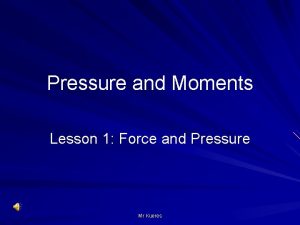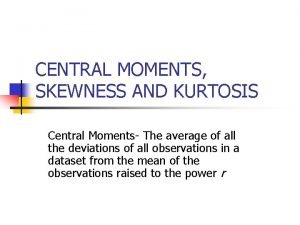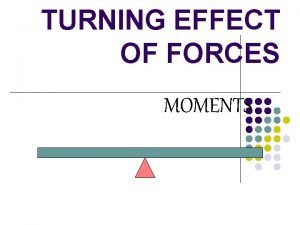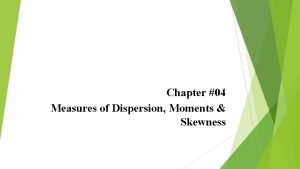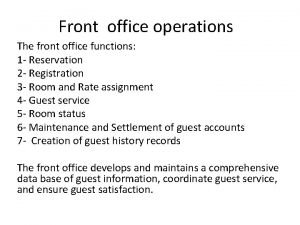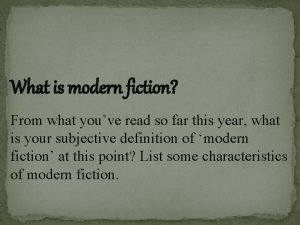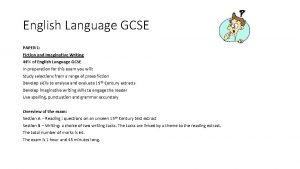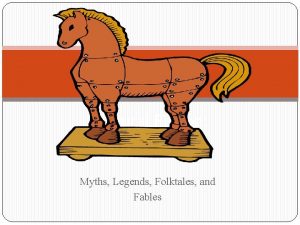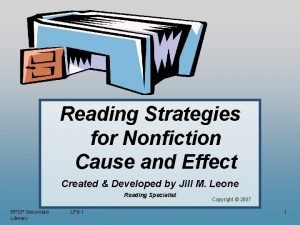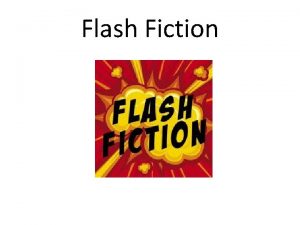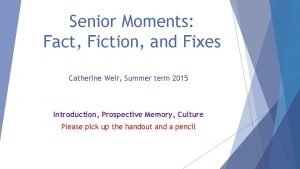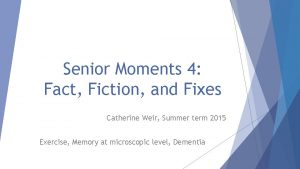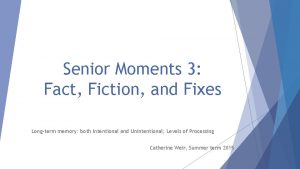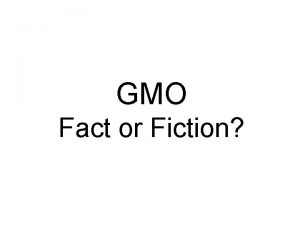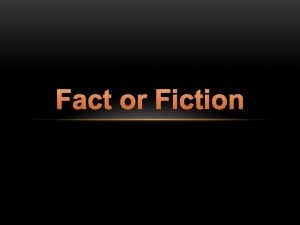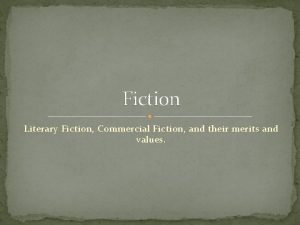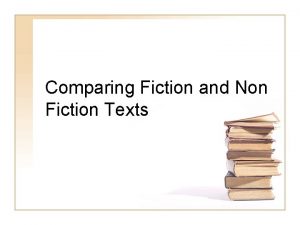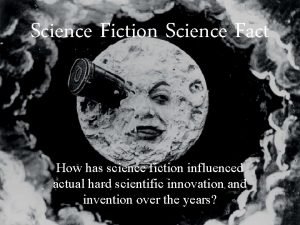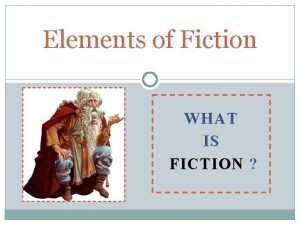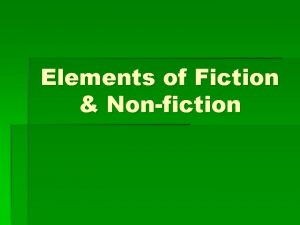Senior Moments 2 Fact Fiction and Fixes Shortterm























- Slides: 23

Senior Moments 2: Fact, Fiction, and Fixes Short-term memory, Working Memory Training Catherine Weir, Summer term 2015 Pick up handout and pencil – we will be doing cognitive exercises

F, F, and F Fact: a) Working memory is one aspect of cognition that tends to decline with age. Fiction: a) Memory is a single process. Fix: a) Training on working memory is likely to improve working memory scores.

Recap from last class Encode info – Store info – Retrieve info Memory failures may also indicate memory efficiency. Attitudes about aging influence memory: Older adults with negative attitudes about senior memory tend to do worse on memory tasks (and report feeling older). Prospective memory: remembering what you plan to do without prompting -- turning off coffee maker when going on trip; attending your wedding Task 2 1. Event cue best. 1. What were the 3 types of prospective memories? 2. Imagine doing task. 3. Interrupted 2. What was an effective retrieval strategy? memory worse. 3. How did interruptions affect prospective memory?

Ideas about how memory is organized Information from Environment Ø Sensory memory Working Short-term memory Long-term memory 1960 s idea based on information-processing model of Atkinson & Shiffrin, 1968. Short-term memory: short here means a few seconds Examples: Remembering a phone number, combination lock, or sentence. Ø Updated version of memory model that takes account of more research findings. Task 3 Memory Span

WORKING MEMORY – updated version of STM Memory not only STORES information, it PROCESSES information Baddeley & Hitch, 1974 ILLUSTRATIONS when we use our WORKING MEMORY Math: (2 x 3) – 2 = 5 T / F? 2. Logic: letter sequence (AB or BA), statement about sequence, you decide True / False B A A follows B True / False B A B is followed by A True / False A B B does not follow A True / False 3. Language processing a. Where there’s a will, I want to be in it. b. In a democracy, it’s your vote that counts. In feudalism, it’s your count that votes. 1.

Evidence for SEPARATE kinds of memory: Working Memory differs from Long-term Memory Cognitive tests: different factors affect WM & LTM. Rhyming words are hard to remember in the short term; rhyming does not influence long term memory very much. § Different brain regions are active for the different modules of memory. Frontal regions are important in Working Memory. § Brain damage: Some patients (anoxia, encepthalitis) cannot learn words, but working-memory span is same as non-patients. Others (surgery) can remember long-term material but have impaired working-memory span. §

Brain scan data from GMU labs Strenziok, Greenwood, Santa Cruz, Thompson, Parasuraman 2013 Had to drop the graphics to reduce size of file for Doc. Store. This was a scanned picture of brain scan data for working memory and episodic memory (one of the pieces of Long-Term Memory)

WORKING MEMORY: Important Findings Environment WM LTM 1. Rapid forgetting: e. g. XRQ items 2. Middle of list of unrelated words forgotten more than ends. Consistent with interference as a major cause of forgetting Glanzer & Cunitz, 1966 Primacy Recency

WORKING MEMORY - Important Findings cont’d 3. Limited Capacity of Working Memory. MEMORY SPAN § What type of material – digits 9. 3 items, letters 7. 3 § Length of words – greater memory span for shorter words. hint, verb (6. 7 words) vs. advantage, occasion (5. 1 words) Mueller et al. 2003 § Chunking the material – A I C S R I I B F Stretch Break – 2 minutes Miller, 1956

Working memory has many subunits 1. CENTRAL EXECUTIVE – controls attention (what you select to see, to hear, to touch, …); doesn’t store. Flashlight in dark 2. VISUAL-SPATIAL SKETCHPAD – stores spatial information briefly – recall map while following friend’s conversation 3. BUFFER (EPISODIC BUFFER) – stores/combines information briefly from parts of working and long-term memory. (2 X 3) - 2 = 4 4. PHONOLOGICAL LOOP – stores speech information briefly – listening to sentence while remembering/generating own

Neural evidence: Different places in brain for different elements of working memory Smith & Jonides 1999 Visual-spatial sketch pad Memory for images of objects (pink) Memory for location of objects (blue)

Frequent cognitive method to study Working Memory: Memory when doing 2+ things at once Dual task studies: Play chess and do something else. Chess players – novices and masters Articulatory suppression – say word “see-saw” over and over rapidly Visual-spatial suppression – press keys on keypad in a pattern over and over rapidly Central executive suppression – produce series of random digits Robbins et al. 1996

Central executive 3 functions of Central executive 1. Planning - steps in starting a car 2. Coordinating mental processes – monitor to see if plan is working - listen for engine, look at display on dashboard 3. Inhibiting irrelevant information & sustaining attention to taskfocus on starting car, inhibit thinking of errand Evidence comes from • People with dysexecutive syndrome • People driving while talking with a passenger or using a cell phone or texting -- Strayer

Strayer studies of distractions while driving Relating this to Working Memory 1. 2. Distraction was involved in almost 25% of accidents in 2012 a. 2012: ~3, 500 died; 420, 000 injured in distracted driver accidents b. 67% of drivers report having used cell in car in last month (US, Europe) Distractions while driving – cognitive attention, vision, manual skills a. Texting (sending & receiving): 23 times as likely to have accident b. Cell phone conversation: very distracting c. Books on tape/ radio / music: little distraction when hazard occurs d. Passenger: actually help to direct attention to driving

Visual-spatial Sketchpad Two kinds of information in this part of working memory. Memory for what object is (Visual aspect – form, color) Memory for where object is (Spatial aspect - location) Students could do a spatial task at same time as playing computer game only after much practice with Space Fortress. Logie 1988 Capacity of sketchpad is about 4 objects: when deciding if one thing in an array has been changed.

Visual information stays in system briefly How long does an image stay in the visual system? Sperling called this iconic memory? Sperling, 1960 s Icon lasts up to ½ second What can you recall from this briefly – presented grid of letters ** R W F K T X Z N C B D Y

Processing language in Phonological Loop “ECHO” Listen to someone saying telephone number. Then dial it on a phone. We “hear the sounds” when dialing. Try it. Best memory for beginning of information. Good memory at end of information stream if info is non-speech. 703 455 1154 Crowder, 1972

Phonological Loop Phonological similarity effect – when words share a sound, the working memory scores are lower. Baddeley, 1966 Studies with articulatory suppression while doing memory task: muttering “the-the” while learning words. If phonological loop is part of learning, then worse memory with “the-the” than without.

Episodic buffer Buffer to combine information from phonological loop, sketchpad, and long-term memory. 14 + 18 + 22 Memory study showing long-term memory influences working memory recall. Darling & Havelka, 2010 Task: remember random digits in order. 3 different ways of presenting digits 1. Presented in one place visually 2. Arranged along a horizontal line 3. On a keypad similar to that on telephones. If long-term familiarity with presentation method influences the memory (in Episodic Buffer), then the keypad condition will be best. The students had better recall memory in the 3 rd condition.

Training to Improve Working Memory Karbach & Verhaegen 2014; Hurley 2013 Smarter (book) “Making Working Memory Work” – § Declines with age without intervention. § Inconsistent findings about how to overcome losses Card matching test Ronnberg et al. 2014 Combined results of ~50 studies § Studies considered working memory training. § Older adults were 60+ years when trained o Trained group compared to Active or Passive control group. o Older adults compared to younger adults in some studies.

Comparing Training Groups Training group might practice memory strategy like chunking items Active control group might do crosswords or rate artworks. Passive control might participate in socials. 1. Training groups improved more than either active or passive control group on the task in the training (by ½ SD). 2. No statistical difference between active & passive controls. 3. Group comparisons: Improvement on non-trained tasks was greater for trained groups than for control groups.

Summary of Working Memory Research 1. Working Memory Findings a. Rapid forgetting --- make recall immediate b. Better memory for information at start of list – put important stuff first c. Chunk items together -- draw on previous experience 2. Working Memory subunits a. Central executive – avoid irrelevant material, focus on task at hand b. Visual spatial sketchpad – practice to extend memory span c. Phonological loop – choose verbal items that do not share a sound d. Episodic buffer – rely on previous experience, practice this

F, F, and F Fact: a. Memory has several modules for different aspects of remembering: Working memory (WM), Long-term Memory (LTM). b. Working memory involves processes for performing tasks as well as places to store information. WM predicts IQ scores fairly well. Fiction: a. All memory declines with age. b. If you forget the middle of a phone number when dialing, you might have Alzheimer’s Disease. c. Memory is a single process. Fixes: a. Training on working memory tasks improves working memory. b. Good memorizers learn strategies like chunking items & use the strategy when they need to remember.
 #shortterm
#shortterm Shortterm housing
Shortterm housing Ies veles e vents
Ies veles e vents Mr spuffington fixes it himself
Mr spuffington fixes it himself Fixes arzneimittelexanthem
Fixes arzneimittelexanthem Narrative nonfiction elements
Narrative nonfiction elements Fiction and non fiction activities
Fiction and non fiction activities Science fiction is a genre of speculative fiction dealing
Science fiction is a genre of speculative fiction dealing Contemporary realism literature
Contemporary realism literature There are no transitional fossils fact, fiction or opinion
There are no transitional fossils fact, fiction or opinion Transforming moments grade 12 short story summary
Transforming moments grade 12 short story summary Pressure force area worksheet
Pressure force area worksheet Platykurtic curve
Platykurtic curve Clockwise and anticlockwise moments examples
Clockwise and anticlockwise moments examples Measure of dispersion moments and skewness
Measure of dispersion moments and skewness Haro success story
Haro success story What are the basic activities of front office
What are the basic activities of front office Alonzo tracy mourning high school
Alonzo tracy mourning high school Department of health and senior services missouri
Department of health and senior services missouri What is modern fiction
What is modern fiction Paper 1 fiction and imaginative writing
Paper 1 fiction and imaginative writing Brer possum's dilemma
Brer possum's dilemma Nonfiction cause and effect
Nonfiction cause and effect Flash fiction vs short story
Flash fiction vs short story

